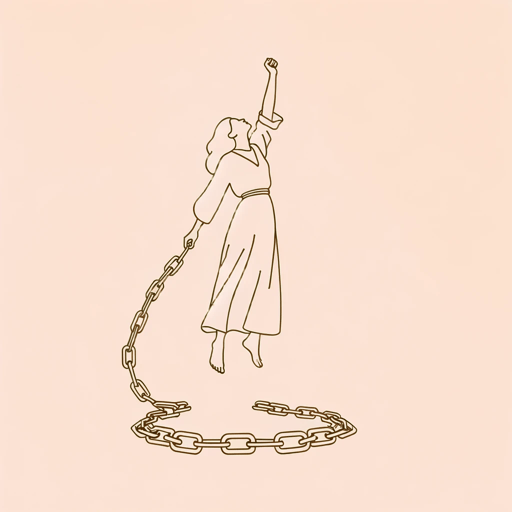53 pages • 1 hour read
Germaine GreerThe Female Eunuch
Nonfiction | Book | Adult | Published in 1970A modern alternative to SparkNotes and CliffsNotes, SuperSummary offers high-quality Study Guides with detailed chapter summaries and analysis of major themes, characters, and more.
Summary and Study Guide
Overview
The Female Eunuch by Germaine Greer is a nonfiction work of second-wave feminism. It was originally published in 1970 by MacGibbon & Kee Ltd., and this guide references the Harper Perennial Modern Classics edition published in 2008. Included in this edition is the 21st-anniversary foreword wherein Greer revisits the work in 1991. Greer is an Australian writer, academic, and radical feminist. This book is one of the most important texts in guiding the trajectory of feminism in the mid- to late-20th century. This book contains analysis of rape and other forms of sexual violence, and this guide discusses these topics as they apply to the text and feminist theory.
Summary
The primary argument of this work is that traditional patriarchal society hates women, and women internalize this hatred to the point that their bodies and sexual desires subconsciously disgust them. This disgust severs the tie between women and their sexualities, rendering them “eunuchs,” unable to access the joy and pleasure of sex. Greer’s focus of discussion in this book is on Anglophone societies, particularly the United Kingdom, Australia, and the United States. The Female Eunuch is primarily an analysis of the suburban nuclear family and cisgender, heterosexual white women from the middle to upper socioeconomic classes, so it is not an exhaustive work.
As a radical feminist, Greer staunchly opposes the idea of achieving women’s liberation through changes to existing sociopolitical structures. Radical feminism is the belief that for women and men to be equals in all aspects of life, all existing sociopolitical structures must be abolished because these structures have always been based upon patriarchal values that disadvantage women. A primary component of this outlook is the questioning of existing norms to uncover biases as they exist within deeply entrenched social practices, such as marriage, child rearing, and behaviors deemed as socially acceptable. Radical second-wave feminism is largely a response to first-wave feminism that sought change through pre-existing legal channels.
As a work of second-wave feminism, The Female Eunuch focuses on the primary tenants that defined the movement: bodily autonomy, especially concerning birth control; equal rights in the workforce; rectifying other legal forms of discrimination against women, especially practices concerning marriage and divorce; and reassessment of the family dynamic. When Greer originally published this book, women across Europe and North America were still legally excluded from many domains of work and the right to receive equal pay for equal work. Greer sees women’s sexual liberation as a primary mode of altering these systems because sexual liberation entails liberation from the overall control of oppressive systems. By reclaiming their bodies and sexualities, women who can achieve sexual liberation can also reclaim their rightful place in society as equal to men by establishing themselves as the agents of their own lives.
This book is notable for its discussion of nontraditional and taboo topics. Greer openly discusses menstruation, sexual intercourse, masturbation, and sexual violence, never shying away from using expletives or offering graphic detail. She aims to normalize openly discussing women’s bodies and sexualities as a necessary step toward sexual liberation.
There are four main parts in this book—“Body,” “Soul,” “Love,” and “Hate”—and it concludes with a much shorter final part titled “Revolution.” Each section guides the reader through the struggles women face to illustrate how sexist practices manifest in the world. Beginning with the physical components of a woman’s anatomy, “Body” discusses the ways in which sexist practices regulate women’s bodies and how they teach women to hate the features that define their sex. “Soul” takes a more metaphysical approach and illustrates indoctrination into sexism as it occurs throughout different stages of a woman’s life. “Love” examines the ways in which abstract notions of love solidify and sanction sexist practices in everyday life. “Hate” extrapolates on how women grow to hate themselves and how these feelings fester and manifest in the real world. The book concludes with “Revolution,” which is the most ambiguous section; it primarily asks questions of what might be in a revolutionized future after the abolition of current sociopolitical systems and suggests the various ways in which women might achieve these far-reaching goals.
Feminism is a dynamic issue, and its changing nature renders some components of this book outdated, especially Greer’s discussions of exact figures or trends in feminist ideologies. Further, she uses some transphobic, racist, and anti-gay language that might be offensive. Modern fourth-wave feminism is largely inclusive of the LGBTQ+ community and women of color, but second-wave feminism was still negotiating the relationship between women and other marginalized groups. Older feminist work remains relevant to illustrate how the same issues persist and to illuminate the progress made over time.


